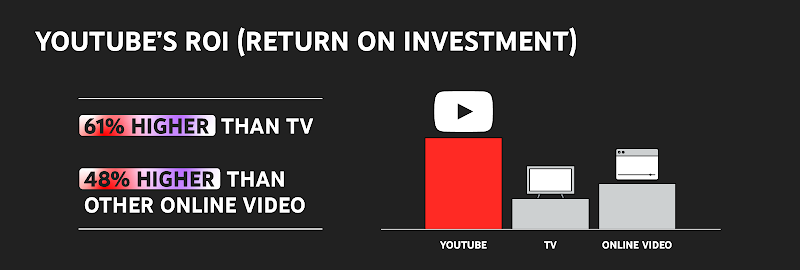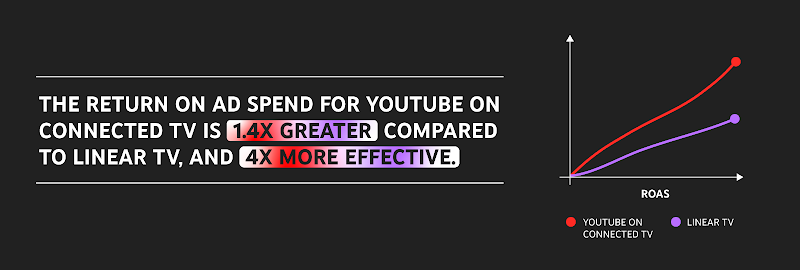This is part 2 of a 2-part series on the reach, relevance, and results that brands are seeing on YouTube on connected TV. Read part 1 here.
For countless Canadian and global brands, YouTube is the core of their advertising strategy.
But Canadians have shifted their habits — they are watching YouTube not just on their personal devices, but on their living room TVs where they are streaming content via connected TV. This has cemented YouTube’s place in the premium content conversation, and brands are now seizing the opportunity of YouTube in the living room.

Source: Google/Talk Shoppe, Canada, whyVideo, n=2,000 weekly video viewers 18-64 (CA), fielded Jan. 30, 2023–Feb. 18, 2023.
The potential for brands to maximize their investments and reach more Canadians in the laid-back, connected TV viewing environment is growing exponentially. As of December 2022, more than 17 million people streamed YouTube on their TV in Canada.1 And according to a survey by Talk Shoppe, the vast majority of Canadian respondents (90%) say that YouTube “is TV” when viewed on their connected TV screens.2
YouTube is equipped with new format innovations and AI-powered solutions to drive leading results in a brand-safe environment.
With the growth of YouTube on connected TV, it is now more important than ever for marketers to clearly identify it in their marketing mix models (MMMs). This allows advertisers to better evaluate performance and inform their marketing decisions.
Here’s a look at how two Canadian brands did just that.
Shaking up the MMM to maximize efficiency
In the past, linear TV is where brands have directed the lion’s share of their budgets. But that has changed. Research shows that brands are seeing new opportunities and a bigger return on investment (ROI) on digital platforms like YouTube on connected TV.
Based on a custom Nielsen meta-analysis of MMM studies conducted in Canada that measured YouTube and TV, the ROI with YouTube was 61% higher than TV, and 48% higher than all other online video.3

Source: Google-commissioned Nielsen Meta-Analysis, Canada, yearly MMM results across CPG brands, 2020–2022.
L’Oréal Canada saw great results with YouTube on connected TV, so the brand began a more aggressive media mix shift toward connected TV with the goal of improving purchase intent, ad recall, and search lift across several of its beauty brands.
The team saw significant bumps across all of those indicators. With an increased investment in connected TV, their cost to drive awareness became 68% more efficient, and their cost to drive ad recall was 21% more efficient.
Further, connected TV proved to be the most efficient device in driving purchase intent, and L’Oréal Canada’s approach to testing also opened its doors to boost reach and awareness to viewers who have already pivoted away from cord-connected content experiences.
In particular, L’Oréal’s Garnier Olia hair colour campaign achieved some of the most groundbreaking results. The team increased their spend on connected TV devices by 124%, which boosted searches for “Garnier Olia” more than 300%. This was a best-in-class lift for both purchase intent and ad recall across its brands, and L’Oréal Canada is now actively boosting its investment in connected TV in future campaigns. Watch this video to learn more about L’Oréal Canada’s success with YouTube.
Shifting gears to supercharge ROI
Our custom analysis with Nielsen found that on average, the return on ad spend for YouTube on connected TV was 1.4X greater compared to linear TV, and 4X more effective.4

Source: Google-commissioned custom Nielsen Meta-Analysis, Canada, yearly MMM results across 18 unique CPG brands in Canada containing YouTube CTV and Linear TV investment, 2021–2022.
But the fact is, according to the Nielsen analysis, as much as 88% of brands are underinvested in YouTube relative to linear TV when comparing brand investment levels required for maximizing ROI.5
And Hyundai Canada was looking to do just that — maximize its ROI to reach the right audience for its new electric vehicle (EV) campaign.
With the widest range of EVs in Canada, the Hyundai team wanted to effectively bring their award-winning technology to life through their new brand platform, “We make WAH,” which is a nod to the automaker’s Korean heritage. They decided to invest more into YouTube, partnering with their agency, Innocean, to build a cohesive cross-channel media plan to amplify their reach.
Together they evolved Hyundai Canada’s strategy to a TV and connected TV always-on approach, shifting 20% of the brand’s previous TV investment into connected TV. This plan also included a significant investment into YouTube on connected TV specifically, accounting for 50% of total connected TV spending.
Prioritizing a connected TV strategy on YouTube offers more opportunities for brands to extend their reach beyond traditional TV.
Hyundai Canada’s pivot proved to be a record-breaking achievement for the brand. This connected TV campaign increased Hyundai’s brand familiarity by 16%, its brand opinion by 8%, and its brand consideration by 21%. Additionally, both familiarity and consideration increases were highest among Hyundai Canada’s competitors.
Streaming and TV are essentially synonymous for Canadians these days. Prioritizing a strategy for YouTube on connected TV offers more opportunities for brands than ever before to maximize efficiency, extend their reach beyond traditional TV, and drive the business results they want.


